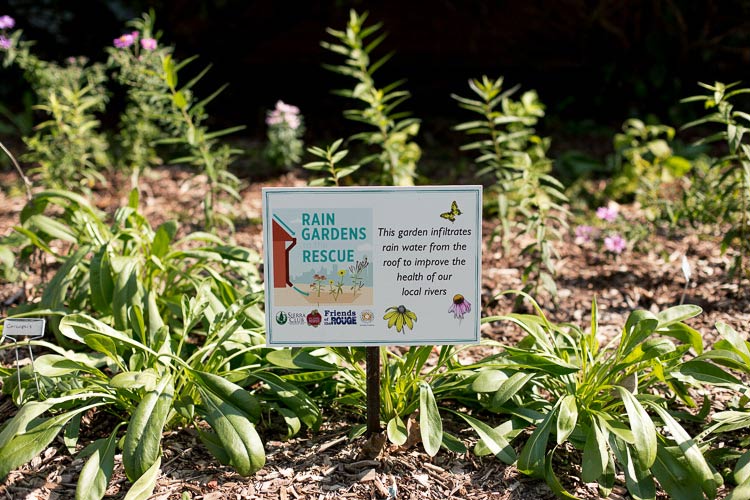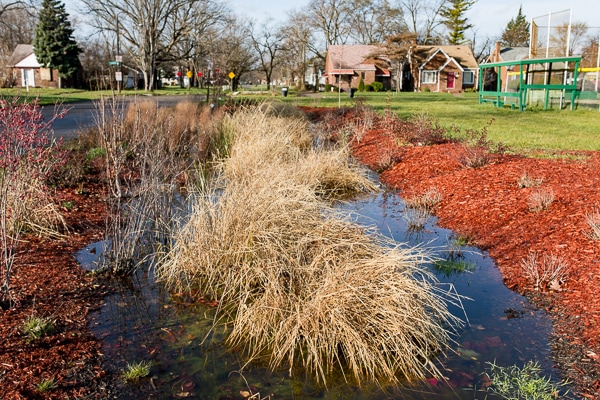Detroit's combined sewer system collects billions of gallons of stormwater runoff and snowmelt, resulting in combined sewer overflow and flooded basements and streets every time there is a heavy rainfall. Detroit aims to replace grey infrastructure with more green infrastructure to help relieve the sewer system. The city’s abundance of vacant land is an advantage in this case, as it provide ample space to manage stormwater through green infrastructure. A decentralized approach like green infrastructure will not only create healthy communities and ecosystems, but also could leverage investments in green infrastructure to help promote local workforce training.
To reduce stormwater inputs to the sewer system, the Detroit Water and Sewerage Department (DWSD) launched a drainage charge and credit program in October 2016. Property owners are charged at a monthly rate of $750 per acre of impervious area. For example, a 1,000 square foot impervious space (such as a rooftop and paved driveway) would be charged $17.21 per month, or $206.61 a year. Residents that install green infrastructure such as rain gardens and pervious pavers, on their property can earn credits on their water and sewer bills (See more from DWSD's presentation for property owners).
The Detroit Future City (DFC) Implementation Office, an independent non-profit working to achieve Detroit’s Strategic Framework, has been spearheading green infrastructure projects. With the help of $2 million in federal funding, DFC has begun changing 30 to 50 vacant lots into green spaces and are working with the DWSD to finalize plans to implement more green strategies. A mini-grant program by DFC awarded ten community-led projects $6,500 each to start revitalizing vacant land. Called the Working with Lots mini-grants, DFC awarded up to $5,000 cash for materials and construction, and up to $2,000 for signage, education and maintenance, as well as pro-bono technical assistance. DFC also put together a Field Guide to catalog Working with Lots projects and encourage new ones. The Field Guide provides some useful tools for stormwater management, as well as gardening and farming in Detroit.
Model D, a Detroit-based weekly online magazine, has been covering many of Detroit’ s green infrastructure projects, including the ones featured below:
- General Motors built out a 50,000 gallon storage tank that filters stormwater to feed the plant’s cooling towers. Water is then further purified to be used in the plant’s sludge system to break down chemicals used in the factory. In the future, GM hopes to provide purified water to Detroit Renewable Power which produces steam energy. All these systems combined would save GM $2.3 million a year, quickly making back the $3.1 million cost.
- A collaborative project between Keep Growing Detroit, Sierra Club and Friends of the Rouge, called Rain Gardens to the Rescue, empowers residents to install rain gardens on their properties. The program utilizes native plants grown by Keep Growing Detroit, and purchases material from local businesses, developing a local economy for green infrastructure. In its first year, the program granted 13 residents the plants and supplies for 13 rain gardens, which together manage 1,600 gallons of rooftop runoff per storm.
- A tributary to the Rouge River used to run through Northwest Detroit’s Stein Park, but was buried long ago. The area is now covered with playfields and floods when there is significant rainfall. High schoolers from Detroit Institute of Technology were engaged on finding a solution to the flooding. Students were taught Google SketchUp and the engineering and landscape components of green infrastructure to help with the design of Stein Park’s rain garden. Involvement in the project has also created a sense of ownership, and the students encourage others not to throw trash in the rain garden. The Stein Park rain garden is only a small area of the park, but there are plans for more rain gardens and pervious pavers in the parking lot.
Check out more examples through ModelD's green infrastructure series.


 RSS Feed
RSS Feed